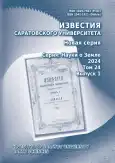The analysis of an underground source water chemical composition located in the floodplain of the Malka River, the largest river flowing through the territory of the Kabardino-Balkarian Republic, is presented. Data on the quantitative content of the groundwater ion-salt composition components serve as indicators to identify background concentrations of pollutants in river waters. The observation results of the intra-annual dynamics of flow, temperature, transparency, pH, mineralization, hardness, permanent oxidability, concentrations of carbonates, bicarbonates, chlorides, sulfates, nitrites, nitrates, and total iron are presented. The qualitative trace element composition has been determined. The results of sanitary and microbiological analysis are presented. The theoretical analysis allows us to conclude that the chemical composition of the water under study follows general patterns. The constancy of the underground source waters temperature indicates the deep occurrence of aquifers. The chemical composition of water is determined by the composition of minerals and rocks, which it comes into contact with, remains almost constant throughout the year and, to a small extent, depends on climatic conditions on the surface. Data on the concentration of components of the ion-salt composition and microflora characterizing the water quality of an underground source were obtained. The water of an underground source refers to neutral, fresh, medium hardness, bicarbonate waters that are not contaminated with pathogenic microflora.
 4-10
4-10


 11-18
11-18


 19-25
19-25


 26-31
26-31


 32-40
32-40


 41-48
41-48


 49-55
49-55


 56-70
56-70


 71-73
71-73











